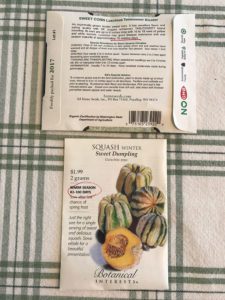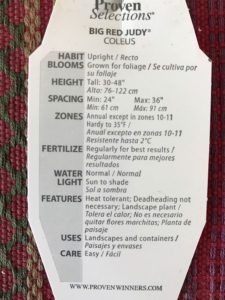March 5 Column: Selecting Plants and Seeds

My garden columns seem to be coming fast and furious now that my writing season is underway! Today’s is about important regional considerations when selecting plants and seeds. Here is a link to it, in today’s edition of The Spokesman-Review: Know your zone to pick the right plants. (or you can read my column lower in this post)
While this might seem like a dull topic, I feel this information really needs to be covered. This especially applies to those who are either new to the area or brand-new gardeners. After all, I want everyone to be successful, right?
But no matter where you live in the U.S., it’s crucial that you be aware of your USDA hardiness zone. That way, you can choose wisely when buying perennials, trees and shrubs. That way, your plants should grow well and you won’t waste money on plants that really need a warmer climate. (note: if you don’t know your hardiness zone, here’s a link to the USDA’s interactive zone map)
In my column, I mentioned how the USDA updated their hardiness zone map a few years ago. That moved the Spokane area up from zone 5 to zone 6. I also mentioned how I tend to err on the side of caution with my plant purchases. My goal is to select plants hardy at least down to zone 5, but even lower is better.
That’s for two reasons. There are many microclimates throughout Spokane and its outlying areas. Even though our winters aren’t as cold as they used to be, you never know when Mother Nature is going to be sneaky. So take that zone 6 label with a grain of salt!
OK, here is this week’s “Everyone Can Grow A Garden!” video that expands on today’s column. I hope you are enjoying them so far!
Garden column: Selecting Plants and Seeds
by Susan Mulvihill
When purchasing trees, shrubs and perennials, it’s a very good idea to know which USDA hardiness zone you’re located in. The zone system is based on the average minimal temperatures each region drops to during the winter months.
For many years, the Inland Northwest was a mix of zones 4 and 5 because we often dipped down to about -20 degrees F. A few years ago, the USDA looked at updated minimal temperature information and decided this region is primarily in zone 6. That means the new minimal temperatures range from -5 to -10 degrees F. Those living in outlying areas, including myself, tend to take a cautious approach to plant purchases by selecting ones that are hardy in zones 5 or lower.
Don’t engage in zonial denial!
Oftentimes, gardeners will engage in what has been amusingly coined “zonal denial” and buy a plant that isn’t hardy enough. Because it’s so desirable, they are certain it will grow in their garden. Unless you’re willing to let the plant die a painful death and waste money, this really isn’t a good idea.
If you’re unsure of your zone, go to the USDA’s interactive map at planthardiness.ars.usda.gov/PHZMWeb and enter your zip code.
Considerations for selecting vegetable plants and seeds
When selecting vegetable plants or seeds that require a long growing season — such as tomatoes, winter squash and melons — it’s important to know how many frost-free days our region has. Our last frost of the season is typically in mid-May and the first frost tends to come in mid- to late September, which gives us around 120 frost-free days. This can vary so it’s always a good idea to keep an eye on the weather forecasts early and late in the season.
When I’m looking for a tomato variety to grow, I check the seed packet or plant tag for the “days to maturity” information. The number refers to the time it takes a transplanted seedling to produce mature fruit. Even though the number is based on the region the cultivar was developed and grown in, I still find it useful because it lets me know if it’s worth considering for this region.
Short-season tomato varieties tend to be a sure thing in the Inland Northwest and include Early Girl, Stupice, Siletz, Oregon Spring, Glacier and Legend. That doesn’t mean you shouldn’t try cultivars that take a bit more time to mature but those needing 85 days or longer could be risky since the harvest season lasts a few weeks.
Some types of winter squash require a long time to mature so be careful when choosing them. For example, Hubbard and Buttercup squash require about 115 days before you can harvest them so they’re not good choices. Blue Ballet is a Hubbard type that takes 95 days and I’ve had good luck with it. Winter squash are too tasty to not grow them, and they store well, so I look for cultivars that require less time to mature.
Pumpkins are a type of winter squash that require anywhere from 90 to 120 days, or more, to mature. I’ve had the best success with New England Pie and Winter Luxury. I enjoy growing my own melons because the sweet, succulent flesh is hard to beat. The plants really love the heat and require a long season to produce mature fruit so I choose early varieties. Examples include Arava honeydew (70 days), Tuscan Napoli (75), Sweet Granite (70) and Minnesota Midget (65-75).


